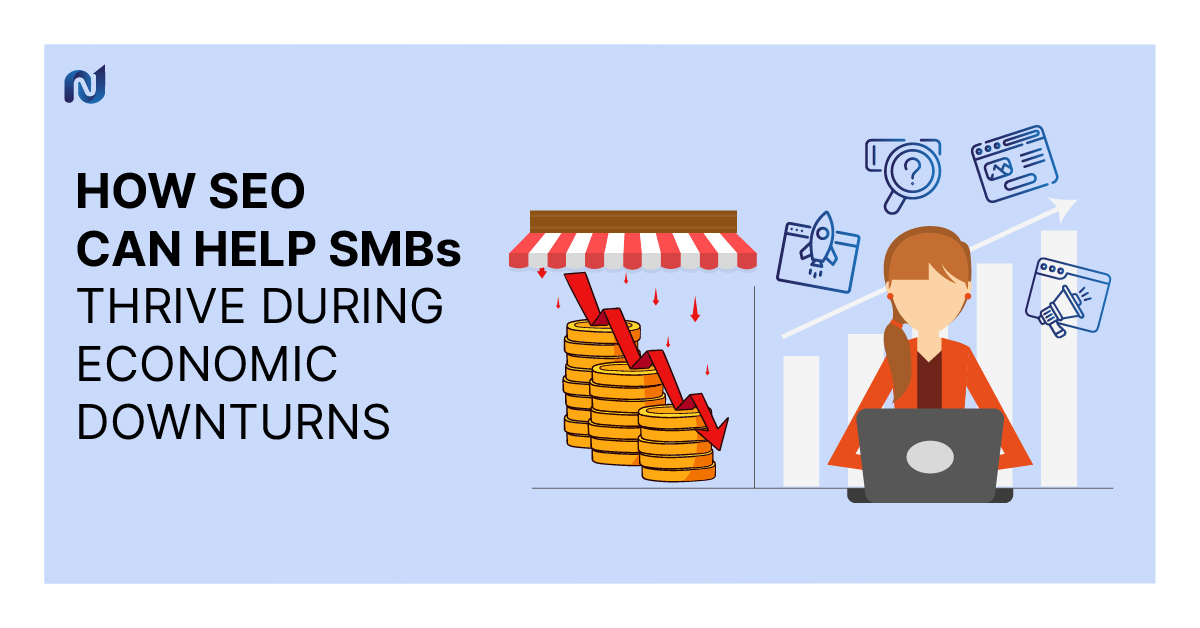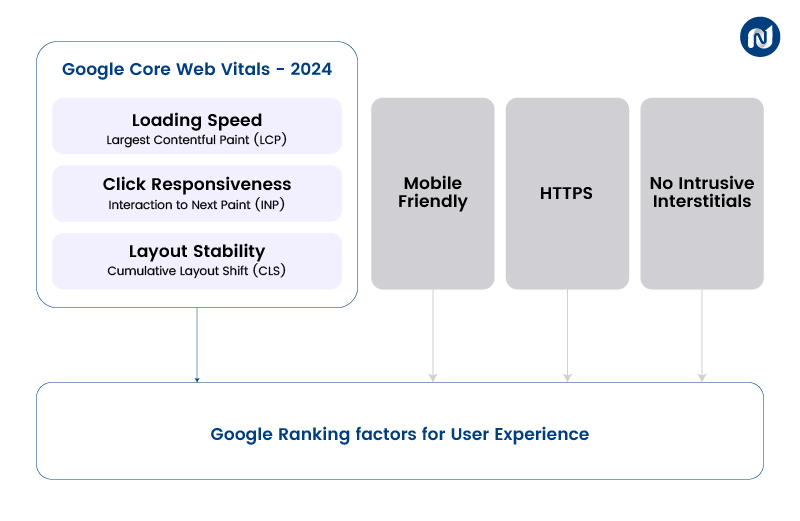
While economic downturns pose challenges for small- and medium-sized businesses (SMBs), they also offer opportunities for strategic growth and positioning. As competitors might cut corners, proactive SMBs can utilize Search Engine Optimization (SEO) as a cost-effective tool to not only weather the storm but also to come out stronger. SEO can enhance visibility and attract potential customers, even during less favourable economic conditions.
Understanding SEO During Economic Downturns
SEO, the technique of optimizing a website to improve its visibility on search engines, is crucial for attracting potential customers. During economic downturns, while other marketing efforts might be curtailed, focusing on SEO provides a cost-effective means to maintain and even increase market share. This involves ensuring that a website ranks highly in search results when potential customers search for relevant products or services.
Implementing Effective SEO Strategies for SMBs
To thrive during economic downturns, SMBs must adopt a range of SEO strategies tailored to not only withstand the current challenges but also pave the way for future growth. Consider the following effective approaches:
Step 1: Building a User-Friendly, Fast-Loading Website
In the context of SEO, simplicity and speed are paramount for SMBs. A streamlined, fast-loading website offers a double benefit: it enhances user experience and aligns with search engines’ preferences, which favour quick and efficient site performance. Here are some key actions to take:
- Design for Simplicity: Instead of emulating the complex designs of existing brochures typical of larger enterprises, SMBs should opt for a clean, straightforward layout. Avoid excessive graphical elements and animations that can slow down page loading times.
- Optimize Core Web Vitals: Core Web Vitals are a set of metrics that Google uses to measure the real-world user experience of a website’s loading speed, interactivity, and visual stability. A website that loads quickly, feels responsive, and avoids unexpected layout shifts is more likely to keep visitors interested and coming back for more. Here’s a breakdown of these three crucial factors:
- Largest Contentful Paint (LCP): This measures how long it takes for the largest piece of content on your webpage to load, essentially reflecting the initial loading experience for visitors.
- Cumulative Layout Shift (CLS): This metric assesses visual stability and reflects how often unexpected layout shifts occur on your website while content loads. Minimizing CLS prevents frustrating experiences for users encountering sudden jumps or movements in the content they’re trying to view.
- Interaction to Next Paint (INP): This score checks how quickly the website responds to user interaction and shows the next intended completed webpage output (paint). This can be in response to a mouse click, a finger tap, or a keyboard interaction. The faster the responsiveness, the lower your INP score. You should try to lower your INP score.
- Select an Appropriate Hosting: The right hosting plan significantly affects website speed. Shared hosting, while economical, can slow down your site due to shared resources. Whenever feasible, choose dedicated hosting to ensure faster load times and a better overall user experience. Cost-effective solutions can be found with providers such as Bluehost, Siteground, and DreamHost, among others.

Pro Tips:
Test Your Website Speed Regularly: Use free website speed testing tools like Google PageSpeed Insights and GTmetrix to identify areas for improvement.
Optimize Images: Reduce image file sizes significantly without compromising quality using tools like TinyPNG or ShortPixel.
Leverage Browser Caching: Enable browser caching to store website elements on visitors’ browsers, minimizing repetitive downloads on subsequent visits. Most web hosting control panels offer a way to enable caching.
Step 2: Ensure Your Website Includes Comprehensive Business Information
Think of your website as your online storefront—it’s where potential customers come to learn about your business and what you offer. Here’s what you should include to make a great first impression:
- Home Page: This is your welcome mat! In clear, simple language, tell visitors what you do and why they should choose you. Highlight your main services, products, and any special offers you have going on.
- About Us: Build trust with potential customers by introducing yourself and your team! Share your story and qualifications. Add a “Meet the Team” section with staff bios and photos to personalize the experience. If you have a physical location, include pictures of that too. Don’t forget to mention any awards or recognition you’ve received.
- Services/Products: Dedicate a page to each service or product you offer. Explain exactly what it is, how it works, and what benefits it provides to customers. Use clear language and include photos or videos to show it in action.
- Gallery: Showcase your products or services visually with a dedicated gallery page. This is a great way for potential customers to see what you offer and get a feel for your style.
- Testimonials: Let your happy customers speak for you! Add a page featuring testimonials and reviews to build trust and credibility.
- Case Studies: Want to show off your expertise? Include case studies that detail how you’ve helped other clients achieve their goals. This is a powerful way to demonstrate your skills and results.
- Contact Us: Make sure you are easily accessible to prospective customers! Provide your contact information such as phone number, email address, and physical address (if applicable), along with a contact form.
- Easy Navigation: Your website should be easy to navigate, like a well-organized store. Use clear menus at the top and bottom of every page, and include quick links for calling, emailing, or contacting you.
- Blog: Keep your website fresh and informative with a blog section. Share articles about your industry, tips for your customers, or updates about your business. This will help establish you as an expert and keep visitors coming back.
Pro Tips:
Conduct a Content Audit: Review your existing website content to ensure it’s up-to-date, informative, and targeted towards your ideal customer.
Include Local SEO Elements: If you have a brick-and-mortar location, optimize your website with local keywords and ensure your Google Business Profile listing is complete and accurate.
Step 3: Optimize Your Business Information to Match Relevant Search Queries
Here’s how you can help people find your business and make your website more relevant in search results.
- Discover What Words People Use to Find Your Business Online: The first step in SEO is figuring out what words and phrases people type into search engines when looking for businesses like yours. This is called “keyword research.” Think about it like this: if someone needs a dentist, they might search for “best dentist near me” or “teeth cleaning prices.” By understanding these keywords, you can tailor your website’s content to answer those questions directly.
- Match What People Search for with Your Website Content: Once you know the words and phrases people use to find businesses like yours online (keywords), figure out which page on your website best answers those questions. Is there missing information about your product or service that people might be looking for? Do you need to add blog articles that directly address these search terms?
- Integrate Keywords into Website Pages: Once you’ve identified the keywords people are searching for, sprinkle them throughout your website’s content in a natural way to improve search engine ranking. Here’s where to focus:
- Head Section (Think of it as the website’s hidden information)
- Title Tag: This is the headline you see in search results, so include your keyword and keep it short and clear (around 50-70 characters). Imagine it as the catchy title of a newspaper article.
- Meta Description Tag: This is a brief description (around 140-150 characters) that appears under the title tag in search results. It should be informative and include your keyword to entice people to click on your website. Think of it as a short summary that convinces someone to read your article.
- Body Section (The main content that visitors see): Include your keywords naturally throughout the text, like in the title, opening paragraph, subheadings, and main content. But remember, prioritize readability! The content should flow naturally and provide value to visitors, not sound like a list of keywords stuffed together.
- Head Section (Think of it as the website’s hidden information)
Pro Tips:
Utilize Keyword Research Tools: Free tools like Google Keyword Planner and AnswerThePublic can help you discover relevant keywords with search volume.
Focus on Long-Tail Keywords: While high-volume keywords might be competitive, consider targeting long-tail keywords (more specific phrases) that are easier to rank for and often have higher conversion rates.
Talk to Customers: Ask your customers how they would look for your type of business in Google and what they would type in the search field. This may give you some unique ideas besides the keyword tools.
Step 4: Promote Your Website to Obtain Mentions, Links, and Citations
Promoting your website to gain visibility involves a variety of strategies, ranging from straightforward tasks to more intricate efforts. Here are various strategies to enhance your website’s presence through strategic link-building and citations.
- Links from Business Listing Sites: Initiate your promotion strategy by creating profiles on essential business listing platforms such as Google Business, Bing Places, and Apple MapConnect. Additionally, explore listing opportunities on industry-specific directories relevant to your niche. It’s critical to ensure that your business information is accurate and consistent across all these platforms to build a reliable presence. For example, if you run a boutique, listings on fashion and local small business directories can be particularly beneficial.
- Links from Social Media: Utilize your social media profiles to drive traffic back to your website. Create business accounts on platforms like Facebook, LinkedIn, Instagram, and X (formerly Twitter) if you haven’t already. Regularly post engaging content, share blog posts, and showcase your products or services with high-quality images. Use relevant hashtags to expand your reach and connect with a wider audience. Engaging directly with comments and messages can also enhance interaction and foster a community feel.
- Links from Online Profiles on Other Sites: Take advantage of any existing memberships or affiliations you have with alumni, business associations, or professional groups by including links to your website on these profiles. Utilize any platform features that allow for content sharing to enhance visibility and direct users to your website.
- Links from Business Partners and Vendors: If you maintain partnerships or vendor relationships, consider establishing a dedicated “Partners” page on your website. Encourage these associates to link back to your site. In cases where vendors feature customer testimonials, provide a testimonial in exchange for a link back, enhancing mutual online credibility and visibility.
- Links through Content Repurposing: Explore various methods to repurpose existing content. The links garnered from these activities act as strong signals to search engines, underscoring your website’s authority and enhancing its ranking for relevant queries. By diligently applying these strategies, you can significantly amplify your online presence and improve visibility in search results, ultimately driving more targeted traffic to your website.
- PDFs: Convert existing data and content into downloadable PDFs for distribution on PDF-sharing sites.
- Photos: Share high-quality images of your operations or products, sharing them on photo-sharing platforms with appropriate tags.
- PowerPoint Presentations: Repurpose business presentations to highlight specific services or insights for sharing on a PPT-sharing site like SlideShare.
- eBooks: Compile related blog posts or articles into a themed eBook, distributing it to reach a broader audience. Make sure the eBook is well-designed and visually appealing.
- Infographics: Create compelling infographics that merge data and graphics, ideal for sharing on image-sharing sites and social media. Ensure these are branded and contain a call-to-action directing viewers back to your website.
Remember, SEO Is a Marathon, Not a Sprint!
While this guide provides a solid foundation, ongoing optimization and expertise are crucial for long-term success.
Want to take your SEO to the next level? For specialized assistance, consider partnering with an experienced SEO specialist. Here at Numero Uno Web Solutions, our team can craft a customized strategy tailored to your unique business goals. We’ll handle the technical SEO complexities and ongoing optimization, ensuring your website ranks higher in search results and attracts a steady stream of qualified leads.
Focus on what you do best; let us handle the SEO! Contact Numero Uno Web Solutions today for a free SEO consultation and discover how SEO can propel your SMB to new heights. Visit our website or call us at (905) 669-1708 to unlock the power of SEO for your business.




